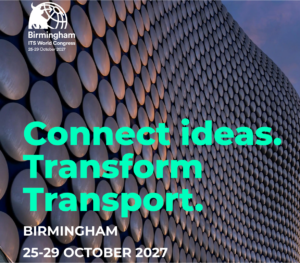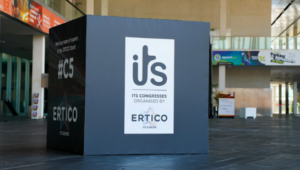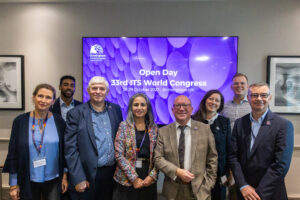The man in charge of reporting on the discussions from the ITS World Congress in Hamburg, Professor Eric Sampson, has released the text of the initial summary of the event.
Read in full below.
I can’t deliver a proper summary over 300 hours of sessions in less than one ! So I’ll not try. But I can paint a picture of an exhilarating week against a background of key activities in the 6 Congress topics. And I can only do this because of the support from my fabulous rapporteur team my universal eyes and ears. My profound thanks to them all; you’ll see their names in the longer Report on the Congress we aim to issue in early December.
TheAutomation and connectivity topic had the largest presence in the Congress again,with more use cases, and more emphasis on actual deployment and take-up of services. Automation received much attention, mainly the higher levels of automated driving (3 and 4) but level 1 or 2 support systems were also addressed such as dynamic distance assist or infrastructure supported Adaptive Cruise Control. Safety and security were prominent such as safety assurance, risk estimation, cybersecurity, and pedestrian safety. Several papers explored the differences in legal approaches to CAV technology within different countries and examined the future role of laws.
Cooperative ITS has definitely moved forward and discussions addressed its integration into day-to-day business, the stakeholders, lessons learned in deployment, and the impacts on a smart transport system. Digital twins and roadside & cloud architectures were recognised as important building blocks of smart transport. Cooperative is currently moving from large-scale testing to widespread use, so the importance to road authorities and operators for improved safety and efficiency is also increasing.
By contrast highly automated public transport seems stuck. Successful pilots of automated shuttle buses, mostly on dedicated infrastructure, have not been adopted. Municipalities and transport companies seem loath to operate regular services. Why is establishing an operational system so much more than running a pilot?. Clearly the road to commercial automated vehicles is not just technology, and it will gain lots of attention in the coming years.
Mobility on Demand, Mobility as a Service
This popular topic has been discussed at World Congresses since 2014 and the publication of the seminal MSc thesis. Popular topics in Hamburg included:
- Impact on travel behaviour
- Equity and inclusivity
- Standardisation
- Business models
- Impacts on the environment
We heard about a number of new ideas including:
- A framework for MaaS scheme indicators,
- User Centred Trusts – a novel data governance framework
- An improved algorithm to solve the dial-a-ride problem of integrating autonomous vehicles into conventional public transport
Sessions and papers, and a vigorous discussion at the ITS National Associations meeting, showed that overall progress has been steady but it is inhibited by many non-technology challenges:
- the complexity of bringing together many different stakeholders in many organisations
- a lack of trust and willingness to share data between and among the sector actors
- managing public subsidies/revenues is not easy when the value chain includes both public and commercial actors.
- public bodies taking too long to update ‒ or perthaps remove ‒ regulations to respond to technology developments
- And let’s be honest – some incumbent transport service suppliers are trying to block the launch of new ventures
Looking ahead there are signs that public authorities and industry partners accept the need to develop the overall organisation, adapt the product development to include greater collaboration on regulations, and encourage a more agile leadership.
Topic 3 was Goods journey from ports to customers. This has often been the smallest topic at Congresses partly as the subject matter is so broad and partly as the supply side has a great many small organisations. However with COVID affecting daily lives across the planet this topic has taken centre stage. Stop and think about it – Transporting the masks you’re wearing today, or supplies of vaccines, or the food delivered to grocery stores or your local take-away – freight & logistics and ITS cannot work without each other.
We have had the best ever response to the Call for Proposals. We had some lively sessions including our first ever Global Forum. Discussions revealed how the sector is steadily becoming digitalised and connected but it remains a fragile system overall: the component parts – loading from origin to ship, ship management, port internal management, port hinterland, delivery fleet management, ‘last mile’ delivery – do not always connect well. Repairing this and speeding up the development of open platforms will continue to be a focus for collaborative work.
Intelligent infrastructure is a relatively recentconcept reflecting major advances in all the ITS technologies. There was much interest in AI, machine learning, new types of sensors and algorithms to generate the intelligence to support network operation. Connected vehicles and communications were big again with connection not just to road vehicles but also water traffic, rail, Unmanned Aerial Systems. Vulnerable road users are becoming a topic of much interest especially the potential for C-ITS use cases for pedestrians and cyclists:
There were relatively few papers and sessions on Electric vehicle charging infrastructure, digital twins, cyber security and overall more papers on trials compared to technical innovations. There were some interesting innovations for example:
● Green light optimal speed advice for buses to incorporate waiting at bus stops
● Directional speakers to provide voice alerts to drivers
● Simulation of routing strategies at an industrial park using A M devices
Overall, different countries are at different stages using intelligent infrastructure. Some countries are cautiously trialling use cases which they think will benefit them. Other countries are past trials and are showcasing the impacts on the wider world such as improved user interaction.
But there is still a chicken – egg situation ‒ operators are not investing in smart systems as too few vehicles are ready to use them; and drivers aren’t being made aware of the benefits so are not buying them and so few vehicles are ready to use them.
Come on boys and girls – do something about this !
There has been an intriguing shift in Topic 5 New services from new technologies. This was almost the smallest topic perhaps reflecting current trends of using technology to improve existing services and applications rather than the creation of new services.
There were numerous Business Presentations with the most popular theme (also for papers and sessions), developments in Urban Air Mobility. In general the emphasis was concepts and business models for mobility in the third dimension and integrating ground and air traffic management. We had new approaches to Traffic Management & Tolling using AI and Deep Learning to manage signals adaptively. Modelling, simulation, monitoring and incident detection were all presented with innovative solutions
Data use was seen as an enabler rather than a new technology or service with several discussions on approaches to sharing and managing data and the need for a collaborative business environment for sharing sector data.
The newest presentations were stressing the need to link to behavioural and social impacts, and exploring how to incorporate future mobility needs and MaaS thinking into town and city planning perhaps using new planning approaches and tools.
Cities and citizens solutions saw some new thinking on designing policies. Most research and technical papers focused on hardware and software solutions to reduce vehicular congestion but, in general, not by diverting motorists to other travel modes. A number also addressed technology innovation to gather and analyse air quality and vehicle emissions data in order to support decisions on air quality-related goals. Road user charging has been a familiar topic for years but discussion featured real-time distance pricing; and time-based charging, once laughed at, is being seriously studied in Hong Kong to address their circulation and parking problems.
We heard about innovative methods of traffic distribution such as real time information dissemination, dynamic modelling, and incentives to nudge drivers into using roads or time periods they might not otherwise consider. Dynamic incentivised trip making is an emerging thought; the challenge lies in how such a system convinces drivers it’s worth their while to change their time or route.
Papers and sessions discussed the components of a “smart city” solution which suggests that implementing a true Smart City vision is not yet realised. The tools that were identified as potentially contributing to smarter cities included making data-informed decisions that drive measurable outcomes; using “dashboard” tools to show where problem areas are to help target solutions; and the need for planners, especially in cities, to do more to understand what is happening ‘on the ground’
An ideal Smart City would presumably rely on multimodal solutions with travellers using technologies to suit particular trips. It was interesting that most papers focused on managing cars, traffic, and congestion with not much emphasis on mode shift.
So overall a marvellous week with thousands of delegates enjoying a face-to-face event after months of screen watching. The Hamburg ERTICO team with MCU have delivered a major event despite Covid constraints.
A speaker in one session put it rather well ‒ “I did experience future mobility now: in sessions, in the Exhibition and at demonstration sites”.
Despite COVID we’re further down the road than we were 2 years ago in Singapore. The road to a mobility world that is Accessible, Equitable, Affordable, has zero fatalities, has zero emissions, Is resilient and is seamless across Continents.
We’re not there yet. Around the globe there are some difficult problems still to be solved. And some of them are all about our behaviour. if we want a better eco-system, we need to cut back all our personal ego-systems. Smaller projects with exciting new ideas are being developed and implemented rapidly everywhere. However the bigger, more ambitious projects with potentially larger impacts are slower moving. They are often constrained by excessive concerns on regulation, integration, competition, and collaboration – none of these is a technology barrier.
You have seen the future here this week; unfortunately, as Ms Obama reminded us, it’s unevenly distributed across the globe. But we gain from sharing knowledge; we learn from each other.
Congresses prove the Chinese proverb: “A single conversation is worth a month’s study of books”.
Join us next year in Toulouse and then Los Angeles for the next progress reports.
(Picture – Eric Sampson)





















